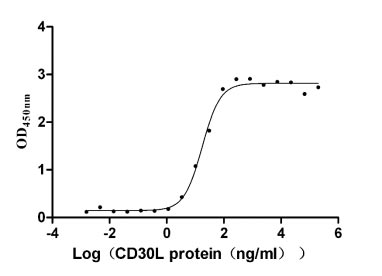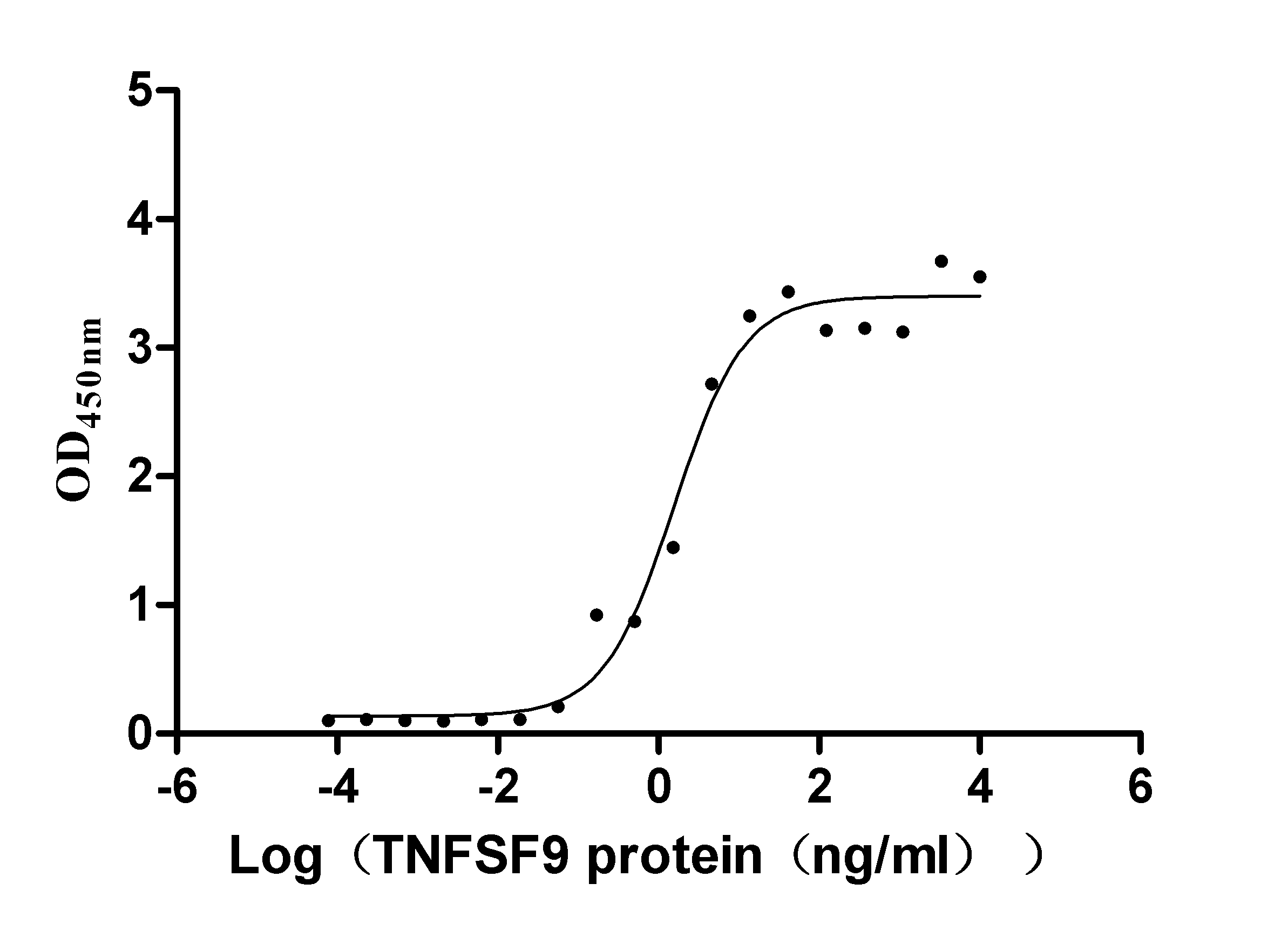Recombinant Mouse Neuroligin-1 (Nlgn1), partial
-
中文名称:小鼠Nlgn1重组蛋白
-
货号:CSB-YP859543MO
-
规格:
-
来源:Yeast
-
其他:
-
中文名称:小鼠Nlgn1重组蛋白
-
货号:CSB-EP859543MO
-
规格:
-
来源:E.coli
-
其他:
-
中文名称:小鼠Nlgn1重组蛋白
-
货号:CSB-EP859543MO-B
-
规格:
-
来源:E.coli
-
共轭:Avi-tag Biotinylated
E. coli biotin ligase (BirA) is highly specific in covalently attaching biotin to the 15 amino acid AviTag peptide. This recombinant protein was biotinylated in vivo by AviTag-BirA technology, which method is BriA catalyzes amide linkage between the biotin and the specific lysine of the AviTag.
-
其他:
-
中文名称:小鼠Nlgn1重组蛋白
-
货号:CSB-BP859543MO
-
规格:
-
来源:Baculovirus
-
其他:
-
中文名称:小鼠Nlgn1重组蛋白
-
货号:CSB-MP859543MO
-
规格:
-
来源:Mammalian cell
-
其他:
产品详情
-
纯度:>85% (SDS-PAGE)
-
基因名:Nlgn1
-
Uniprot No.:
-
别名:Nlgn1; Kiaa1070Neuroligin-1
-
种属:Mus musculus (Mouse)
-
蛋白长度:Partial
-
蛋白标签:Tag type will be determined during the manufacturing process.
The tag type will be determined during production process. If you have specified tag type, please tell us and we will develop the specified tag preferentially. -
产品提供形式:Lyophilized powder
Note: We will preferentially ship the format that we have in stock, however, if you have any special requirement for the format, please remark your requirement when placing the order, we will prepare according to your demand. -
复溶:We recommend that this vial be briefly centrifuged prior to opening to bring the contents to the bottom. Please reconstitute protein in deionized sterile water to a concentration of 0.1-1.0 mg/mL.We recommend to add 5-50% of glycerol (final concentration) and aliquot for long-term storage at -20℃/-80℃. Our default final concentration of glycerol is 50%. Customers could use it as reference.
-
储存条件:Store at -20°C/-80°C upon receipt, aliquoting is necessary for mutiple use. Avoid repeated freeze-thaw cycles.
-
保质期:The shelf life is related to many factors, storage state, buffer ingredients, storage temperature and the stability of the protein itself.
Generally, the shelf life of liquid form is 6 months at -20°C/-80°C. The shelf life of lyophilized form is 12 months at -20°C/-80°C. -
货期:Delivery time may differ from different purchasing way or location, please kindly consult your local distributors for specific delivery time.Note: All of our proteins are default shipped with normal blue ice packs, if you request to ship with dry ice, please communicate with us in advance and extra fees will be charged.
-
注意事项:Repeated freezing and thawing is not recommended. Store working aliquots at 4°C for up to one week.
-
Datasheet :Please contact us to get it.
靶点详情
-
功能:Cell surface protein involved in cell-cell-interactions via its interactions with neurexin family members. Plays a role in synapse function and synaptic signal transmission, and probably mediates its effects by recruiting and clustering other synaptic proteins. May promote the initial formation of synapses, but is not essential for this. In vitro, triggers the de novo formation of presynaptic structures. May be involved in specification of excitatory synapses. Required to maintain wakefulness quality and normal synchrony of cerebral cortex activity during wakefulness and sleep. The protein is involved in nervous system development.
-
基因功能参考文献:
- Study generated a knock-in mouse line in which an hemagglutinin (HA) epitope was inserted into the Nlgn1 gene. Using HA-Nlgn1 mice, study demonstrated the cellular and subcellular localization of endogenous Nlgn1 in cerebellar circuits, providing insights into cell- and synapse-specific roles of Nlgn1. PMID: 30046996
- SynCAM1, Neuroligin-1B and Neuroligin-2A were overexpressed in newborn neurons in the dentate gyrus of 7- to 9-week-old mice. SynCAM1 increased the morphological maturation of dendritic spines and mossy fiber terminals while Neuroligin-1B increased spine density. In contrast, Neuroligin-2A increased both spine density and size as well as GABAergic innervation and resulted in a drastic increase of neuronal survival. PMID: 27473321
- Co-expression of gamma-Pcdhs inhibits the ability of Nlg1 to increase spine density and to induce presynaptic differentiation in hippocampal neurons in vitro. PMID: 28297673
- The alternatively spliced segment 4 (AS4) of NRX genes (Nrxn) is a critical element in selective trans-synaptic interactions. This study evaluated the synaptogenic receptor activity of NL1/2/3 isoforms in a neuron-fibroblast co-culture system, in which the Nrxn AS4 segments are manipulated using SLM2, a selective and dominant regulator of AS4 splicing. PMID: 28939043
- We show that a novel NLGN1 Pro89Leu (P89L) missense variant found in two autism spectrum disorder (ASD) siblings leads to changes in cellular localization, protein degradation, and to the impairment of spine formation. Furthermore, we generated the knock-in P89L mice, and we show that the P89L heterozygote mice display abnormal social behavior, a core feature of ASD PMID: 28841651
- The results indicate that Nrx2alpha and NL1 are targets of Abeta oligomers and that prevention of this interaction reduces the deleterious impact of Abeta oligomers on synapses and cognition. PMID: 28283575
- Neuroligin 1 regulates spines and synaptic plasticity via LIMK1/cofilin-mediated actin reorganization. PMID: 26880202
- Study shows that astrocyte-secreted hevin is a trans-synaptic linker that bridges presynaptic NRX1alpha with postsynaptic NL1B. This way, hevin organizes both pre- and postsynaptic specializations and aligns them across the synapse. PMID: 26771491
- Results are indicative of an altered immediate response of the brain to peripheral stimulation in Nlgn1 KO mice, and suggest a role for NLGN1 in the regulation of cerebrovascular responses PMID: 25595979
- the R451C mutation in the Nlgn3 gene, associated with autism spectrum disorder in humans, confers resistance to induced seizures PMID: 25592157
- This study provided first evidence that NL1 is essential for normal excitatory transmission and long-term synaptic plasticity in the hippocampus of intact animals. PMID: 25713840
- NLGN1 and alpha6 integrin preferentially colocalize in the mature retinal vessels, whereas NLGN1 deletion causes an aberrant VE-cadherin, laminin and alpha6 integrin distribution in vessels PMID: 24860089
- This study demonistrated that amyloid-induced neuroinflammation leads to epigenetic suppression of NLGN1 expression. PMID: 24441681
- This study demonstrate a direct functional interaction between CaMKII and NL-1, two primary components of excitatory synapses. PMID: 24336150
- Data indicate that absence of Neuroligin-1 (NLG1) decreases wakefulness duration. PMID: 23716671
- Results indicate that neuroligin-1 expression selectively increases the degree, but not the onset, of excitatory synapse formation in adult-born neurons. PMID: 23110172
- MDGA binding and suppression of synaptogenic activity was selective for neuroligin-2 and not neuroligin-1 excitatory synapse organizer. PMID: 23358245
- Transcellular competitive processes govern synapse formation and number in developing cortex; NL1 has a central function in these processes. PMID: 23143522
- findings suggest that the loss of Nlgn-1 is associated with some use-dependent destabilization of excitatory synapse organization, and indicate that in the absence of Nlgn-1, the tenacity of excitatory synapses might be somewhat impaired PMID: 22860111
- This study implicated neuroligin 1 cleavage with epileptiform activity and maturation of developing neuronal circuits. PMID: 23083741
- This study presented evidence that combined NL1 and SC1 overexpression triggers excitotoxic neurodegeneration through SC1 signaling at synaptic connections initiated by NL1. PMID: 22542674
- these data reveal a mechanism by which membrane-diffusing AMPARs can be rapidly trapped at PSD-95 scaffolds assembled at nascent neurexin/neuroligin adhesions, in competition with existing synapses. PMID: 21940442
- Neurexins and neuroligins, which constitute large and complex families of fundamental players in synaptic activity, are produced and processed by endothelial and vascular smooth muscle cells throughout the vasculature. PMID: 19926856
- the clustering of synaptic vesicles triggered by neuroligin-1 overexpression required the presence of N-cadherin in neurons PMID: 20534458
- Findings suggest that neuroligin-1 can modulate, in a pathway-specific manner, synaptic plasticity in the amygdala circuits of adult animals, likely by regulating the abundance of postsynaptic NMDA receptors. PMID: 20176955
- These results provide for the first time evidence for an involvement of a neuroligin-neurexin protein network in core symptoms of fragile X syndrome. PMID: 19932134
- findings demonstrate the influence of NL1 expression in vivo on synapse morphology, LTP, and acquisition of spatial learning in the water maze, and draw a link between aberrant synapse morphology, impaired synaptic plasticity, and deficits in learning PMID: 19437420
- These data are consistent with the hypothesis that NL1 dysfunction can lead to autism- and mental retardation-related behavioral abnormalities in part via alteration of NMDA receptor (NMDAR) function. PMID: 20147539
- Study on the expression of NLGN1 in the developing and adult olfactory bulb PMID: 12141453
- Postsynaptic density (PSD) proteins PSD-95 and neuroligin-1 (NLG) are critical for dictating the ratio of excitatory-to-inhibitory synaptic contacts. PMID: 15358863
- Data show that neuroligin 1 is required for proper synapse maturation and brain function, but not for the initial formation of synaptic contacts. PMID: 16982420
- Expression of neuroligin 1 inhibits trans-binding to recombinant neurexins and reduces the density of presynaptic terminals in hippocampus. PMID: 17360903
- Neuroligin1 is essential for presynaptic terminal maturation. PMID: 19628693
显示更多
收起更多
-
亚细胞定位:Cell membrane; Single-pass type I membrane protein. Cell junction, synapse, postsynaptic density. Cell junction, synapse, synaptic cleft. Cell junction, synapse, synaptic cell membrane.
-
蛋白家族:Type-B carboxylesterase/lipase family
-
组织特异性:Brain and arteries (at protein level). Expressed in olfactory bulb. Detected in brain.
-
数据库链接:
KEGG: mmu:192167
STRING: 10090.ENSMUSP00000074565
UniGene: Mm.316080
Most popular with customers
-
Recombinant Human Tumor necrosis factor receptor superfamily member 8 (TNFRSF8), partial (Active)
Express system: Mammalian cell
Species: Homo sapiens (Human)
-
Recombinant Human Tumor necrosis factor receptor superfamily member 9 (TNFRSF9), partial (Active)
Express system: Mammalian cell
Species: Homo sapiens (Human)
-
Recombinant Human C-X-C chemokine receptor type 4 (CXCR4)-VLPs (Active)
Express system: Mammalian cell
Species: Homo sapiens (Human)
-
Recombinant Mouse Cell adhesion molecule 1 (Cadm1), partial (Active)
Express system: Mammalian cell
Species: Mus musculus (Mouse)
-
Recombinant Macaca fascicularis CUB domain containing protein 1 (CDCP1), partial (Active)
Express system: Mammalian cell
Species: Macaca fascicularis (Crab-eating macaque) (Cynomolgus monkey)
-
Recombinant Human Dipeptidase 3(DPEP3), partial (Active)
Express system: Mammalian cell
Species: Homo sapiens (Human)
-
Recombinant Macaca fascicularis Cadherin 6(CDH6),partial (Active)
Express system: Mammalian cell
Species: Macaca fascicularis (Crab-eating macaque) (Cynomolgus monkey)
-
Recombinant Human C-C chemokine receptor type 5 (CCR5)-VLPs (Active)
Express system: Mammalian cell
Species: Homo sapiens (Human)




-AC1.jpg)















